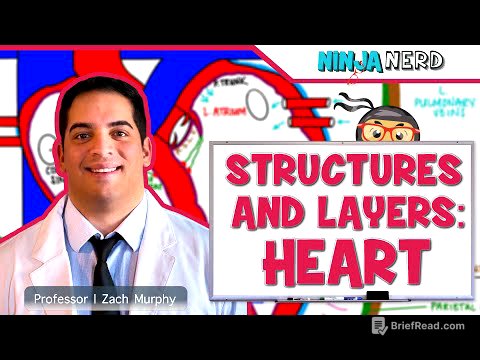Alright, here's a detailed summary of the YouTube video transcript you provided, broken down by chapters and focusing on key details and facts, written in an Indian English style.
TLDR;
This video is a detailed discussion around varicose veins, their diagnosis, and treatment options. It covers a case presentation, various clinical tests, and surgical procedures, along with potential complications and post-operative care. Key takeaways include understanding the different types of varicose veins, diagnostic methods, and the importance of proper treatment to avoid long-term complications.
- Detailed discussion on varicose veins, diagnosis, and treatment.
- Case presentation and clinical tests explained.
- Surgical procedures, complications, and post-operative care covered.
Introduction and Case Presentation [0:00]
The video starts with a greeting on Teachers' Day. A 30-year-old gentleman, a heart patient, presents with complaints of leg pain that worsens with standing and improves with elevation. The pain has gradually increased. The initial discussion revolves around the patient's history and symptoms.
Initial Assessment and Risk Factors [1:58]
The presenter discusses the patient's symptoms, noting the gradual increase in pain and its relation to posture. They explore potential risk factors and differentiate between various conditions like cellulitis and venous insufficiency. The importance of understanding the patient's history and symptom patterns is highlighted to narrow down the diagnosis.
Differential Diagnosis and Symptom Analysis [6:39]
The discussion focuses on differentiating the patient's symptoms from other possible conditions. The presenter emphasises that the pain disappears after lying down or elevating the legs, pointing towards a venous issue rather than neurological. They also touch upon the intermittent nature of the episodes and the absence of night cramps.
Clinical Examination and Key Findings [9:46]
The presenter explains the significance of gravity in causing blood pooling in the lower limbs. They discuss venous hypertension and its effects on capillaries, leading to symptoms. The importance of differentiating between venous, arterial, and neurological pain is stressed, with neurological pain often involving radiating sensations.
Varicose Veins and Related Complications [13:02]
The discussion moves to varicose veins and their complications. The presenter mentions that direct destiny isn't much substance tissue around the ankle, so venous hypertension changes become evident. They also discuss how previously people used to wear shoes which used to cover ankle so that whenever there is resounding readers will prevent the results and culpes.
Further Questions on Patient History [14:42]
The presenter asks whether the patient experiences increased swelling or size of the limb, especially noticeable in the evening and reducing by the next morning after lying down. This history is crucial for suspecting venous issues. They advise against mentioning DVT (Deep Vein Thrombosis) prematurely.
DVT and Varicose Veins [15:38]
The presenter clarifies that DVT and varicose veins are separate entities, although they can co-exist. DVT involves thrombus formation, while varicose veins are dilated, tortuous vessels. The presenter stresses that the history of thrombophlebitis is important.
Physical Examination Techniques [16:48]
The presenter outlines the physical examination, including checking for tenderness, temperature differences, and palpable veins. Examination should be done in a standing position to assess venous insufficiency properly.
Types of Pain and Further Discussion [17:39]
The presenter summarises the discussion, differentiating between arterial, venous, and neurological pain. They transition to discussing risk factors and potential complications.
Risk Factors and Complications [18:53]
The presenter lists risk factors such as long-term hospitalisation and surgery. They discuss potential complications like venous ulcers and the development of phlebitis.
Post-DVT Syndrome [21:06]
The presenter explains post-thrombotic syndrome, which can occur after DVT. This involves damage to the valves in the deep venous system, leading to venous insufficiency. They highlight that even with medical treatment, complete recanalization of the deep system may not occur.
Isolated Incompetent Perforators [23:07]
The presenter discusses cases where individuals have incompetent perforators with a normal deep venous system. They emphasise the importance of identifying a past history of DVT, even if it was untreated.
Treatment Considerations for DVT [24:34]
The presenter insists on knowing the percentage of treatment for DVT and the treatment options, such as low molecular weight heparin. They also caution about bleeding risks if the patient is on anticoagulants.
Chronic Venous Insufficiency and Compression Stockings [25:43]
The presenter discusses chronic venous pain and the use of compression stockings. They question whether the stockings are being used properly and whether they are effective for the specific type of venous insufficiency the patient has.
Smoking and Venous Health [27:51]
The presenter notes that the patient doesn't smoke, which is beneficial. They explain that smoking predisposes individuals to venous problems by interfering with collagen synthesis, affecting vein wall integrity.
Varicose Veins and Associated Syndromes [30:51]
The presenter discusses symptoms associated with varicose veins and conditions like Klippel-Trenaunay syndrome. They differentiate between various venous malformations and their clinical presentations.
Physical Examination Details [32:35]
The presenter provides details of a physical examination, including height, weight, vital signs, and local examination findings in both standing and supine positions. They note the presence of varicose veins, pigmentation, and other skin changes.
Clinical Tests: Trendelenburg and Tapping [34:02]
The presenter describes specific clinical tests like the Trendelenburg test and tapping test to assess venous insufficiency. They explain the significance of the findings in diagnosing the condition.
Trendelenburg Test Explained [43:44]
The presenter explains the Trendelenburg test in detail, highlighting the importance of proper technique. They discuss the positioning of the tourniquet and the expected findings in cases of venous insufficiency.
Perthes' Test [47:58]
The presenter describes Perthes' test, where the patient stands up or sits down, and the veins are observed. They explain how this test helps assess the patency of the deep venous system.
Duplex Ultrasound and Venous Mapping [50:19]
The presenter discusses the importance of duplex ultrasound in venous mapping. They explain how the test helps visualise blood flow and identify incompetent perforators.
Types of Telangiectasias [53:38]
The presenter describes different types of telangiectasias, including intradermal and subdermal. They discuss the appearance and characteristics of these small, dilated vessels.
Diagnosis and Classification [54:52]
The presenter discusses the diagnosis of varicose veins and the CEAP (Clinical, Etiological, Anatomical, Pathophysiological) classification. They explain how this classification helps categorise the severity and characteristics of the condition.
Investigations and Ultrasound [58:16]
The presenter outlines the necessary investigations, including complete blood tests and duplex ultrasonography. They explain the importance of ultrasound in assessing venous anatomy and identifying reflux.
Secondary Causes of Varicose Veins [1:00:33]
The presenter discusses secondary causes of varicose veins, such as high venous pressure due to tumours or pregnancy. They emphasise the importance of ruling out these causes.
Varicocele and Venous Anatomy [1:02:50]
The presenter touches upon varicocele and its relevance in venous discussions. They explain the anatomical reasons why varicoceles are more common on the left side.
Duplex Ultrasound Report Interpretation [1:05:39]
The presenter explains how to interpret a duplex ultrasound report, including understanding the zones and segments used in the report. They also differentiate between thrombophlebitis and phlebothrombosis.
Surgical Options: Stripping and Ligation [1:07:16]
The presenter discusses surgical options, including stripping and ligation of the saphenous vein. They explain the importance of understanding the anatomy and potential complications.
Stripping Procedure Details [1:10:26]
The presenter provides detailed steps of the stripping procedure, including identifying the saphenofemoral junction and mobilising the vein. They discuss the importance of preventing damage to the saphenous nerve.
Modern Approaches to Varicose Vein Treatment [1:14:47]
The presenter discusses modern approaches, such as limited stripping and conservative approaches. They explain the benefits of these techniques in reducing nerve damage and improving outcomes.
Superficial Vein Stripping and Perforator Ligation [1:16:40]
The presenter discusses the importance of stripping the superficial vein and ligating perforators. They explain how this helps disconnect the superficial system from the deep system.
Compression Stockings and Their Role [1:17:27]
The presenter reiterates the importance of compression stockings in managing varicose veins. They explain how stockings help reduce venous pressure and improve circulation.
Radiofrequency Ablation (RFA) [1:18:36]
The presenter discusses radiofrequency ablation (RFA) as a treatment option. They explain the procedure, including the temperature used and potential complications like skin burns and pigmentation.
Sclerotherapy Techniques [1:20:56]
The presenter discusses sclerotherapy, involving injecting a solution into the vein to cause it to collapse. They explain different types of sclerotherapy, including micro-sclerotherapy and foam sclerotherapy.
Foam Sclerotherapy Details [1:22:36]
The presenter provides details on foam sclerotherapy, including the types of solutions used and the technique of creating foam. They explain the benefits of foam over liquid sclerotherapy.
Veinlite Transillumination [1:23:42]
The presenter mentions Veinlite transillumination, a technique used to visualise veins for sclerotherapy. They explain how it helps in targeting the veins accurately.
Telangiectasia Treatment [1:25:06]
The presenter discusses the treatment of telangiectasias, including sclerotherapy and laser therapy. They explain the indications for each treatment option.
Minimally Invasive Surgery [1:28:14]
The presenter touches upon minimally invasive surgery options, such as phlebectomy, performed under local anaesthesia.
Post-operative Care and Complications [1:29:15]
The presenter discusses post-operative care and potential complications, such as pigmentation and skin deformities. They emphasise the importance of patient education and proper follow-up.
CEAP Classification and Venous Disease [1:31:26]
The presenter revisits the CEAP classification and discusses different types of venous disease, including primary and secondary causes.
Lipodermatosclerosis and Venous Hypertension [1:32:52]
The presenter discusses lipodermatosclerosis and venous hypertension, explaining their relationship to chronic venous disease.
Conclusion and Appreciation [1:33:58]
The presenter concludes the session, appreciating the participants and highlighting the importance of thorough preparation and understanding of the subject. They end with Teachers' Day greetings.
Hope this helps! Let me know if you need any further adjustments.









